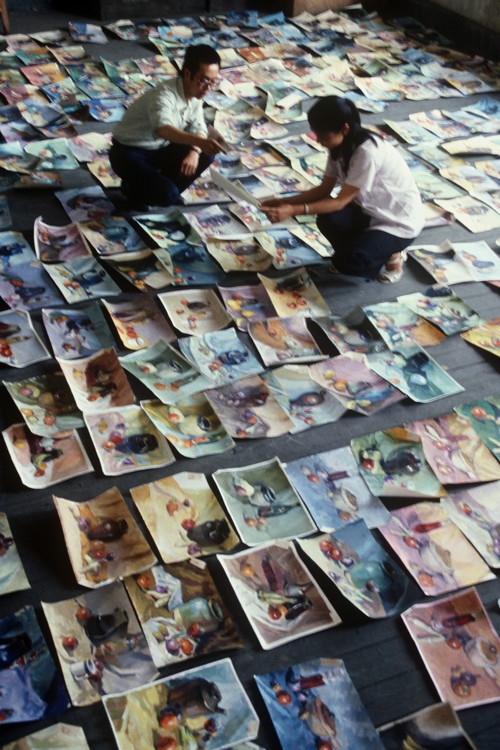
Reviewing admission applications to Zhejiang Academy of Fine Arts, 1977, detail. Zheng Shengtian Archive, AAA Collection.
Learning What Can’t Be Taught reflects on changes in art education in China from the 1950s to the 2000s. It focuses on six artists from three generations who were each other’s teachers and students at the Zhejiang Academy of Fine Arts in Hangzhou. The school, now called China Academy of Art, was established in 1928 as the first art academy in the country. The exhibition explores how Chinese artists across generations learnt in and outside of classrooms, and proposes lines of continuity among these artists: what guidance did they receive from their teachers, and how did this, in turn, influence the way they taught art? On display are rarely seen artworks, archival materials, and video interviews with Zheng Shengtian, Jin Yide, Zhang Peili, Geng Jianyi, Lu Yang, and Jiang Zhuyun.
The Zhejiang Academy is renowned for the number of graduates who went on to become leading artists in the landmark Avant-Garde Movement of 1985 and 1986, which emerged after the Cultural Revolution. These artists include Zhang Peili and Geng Jianyi, who respectively graduated from the Zhejiang Academy in 1984 and 1985. Zhang and Geng tested the limits of their training in Socialist Realism, creating works that were criticised for having “too much emphasis on individualism.”
The sense of individualism was partly made possible with the ethos embodied by two of the most influential artist-teachers, Zheng Shengtian and Jin Yide, who had studied at the Academy in the 1950s, when China’s art education was heavily influenced by the Soviet system. After China’s split with the Soviet Union in 1960, many artists sought inspiration from Eastern Europe and Latin America. However, freedom in art education was short-lived. Following the Great Leap Forward and the Cultural Revolution, art became instrumentalised by politics. Those who survived the campaigns became the main driving force for reforming art education.
In the 2000s, China’s economy grew significantly with the impact of globalisation, and university education expanded. Founded in 2003 at the China Academy of Art, the New Media Department became a pioneer in formalising contemporary art education. Zhang Peili served as the head of department, and Geng Jianyi was among the outstanding professors. At the end of the seven years of operation, the department had more than 300 graduates—including Lu Yang and Jiang Zhuyun, who are two of the most prominent artists of their generation.
Learning What Can’t Be Taught contributes to a history of art education in China and traces the relationships between these six artists within a pedagogical context. While the Zhejiang Academy of Fine Arts promoted diversity and artistic innovation, inspiring generations of artists since the 1930s, its administration and education policies have also been dominated by the Communist Party since the 1950s. This exhibition explores how these six artists were able to carve out space for experimentation for themselves and for others. While they each work with different styles and methods, this project proposes that educational backgrounds can reveal lineages of artistic attitudes, while also complicating conventional narratives about art history in China.
About the artists
Jin Yide (b. 1935, Shaoxing, Zhejiang) graduated from the Oil Painting Department at the Zhejiang Academy of Fine Arts in 1959. Jin studied with Romanian painter Eugen Popa from 1960 to 1962 and was Ni Yide's teaching assistant in 1962 and 1963. He worked as a teacher of the Oil Painting Department from the 1960s to the 1990s. He lives and works in Hangzhou.
Zheng Shengtian (b. 1938, Luoshan, Henan) graduated from the Oil Painting Department at the Zhejiang Academy of Fine Arts in 1958. He was a visiting professor at the University of Minnesota from 1981 to 1983. He taught oil painting at his alma mater and served as the department chair in the 1980s. He moved to Vancouver in the 1990s and co-founded Yishu: Journal of Contemporary Chinese Art, the first English magazine on contemporary Chinese art, in 2002. Zheng lives and works in Vancouver.
Geng Jianyi (b. 1962, Zhengzhou, Henan; d. 2017, Hangzhou) graduated from the Oil Painting Department at the Zhejiang Academy of Fine Arts in 1985. Geng was a co-founder of the Pond Society, a Hangzhou-based artist collective active from 1986 to 1989, and an important figure in China's '85 New Wave movement. He was a professor in the New Media Department at his alma mater from 2004 to 2010.
Zhang Peili (b. 1957, Hangzhou) graduated from the Oil Painting Department at the Zhejiang Academy of Fine Arts in 1984. He was a co-founder of the Pond Society, a Hangzhou-based artist collective active from 1986 to 1989. Zhang served as the director of the New Media Department at the China Academy of Arts from 2003 to 2010. He lives and works in Hangzhou.
Jiang Zhuyun (b. 1984, Hangzhou) graduated from the New Media Department at the China Academy of Arts in 2007 and received a master's degree from the School of Intermedia Art in 2014. Based in Hangzhou, he currently teaches at the School of Intermedia Art.
Lu Yang (b. 1984, Shanghai) received a BA and MA from the New Media Art Department at the China Academy of Art in 2007 and 2010, respectively. She is currently pursuing a PhD at the School of Intermedia Art at the China Academy of Art. Lu lives and works in Shanghai.
About the exhibition
Learning What Can’t Be Taught is curated by Anthony Yung with Özge Ersoy, with the production support of Helena Halim and Cheung Young One.
Dates: 17 December 2020–30 April 2021
Venue: AAA Library, Asia Art Archive, Hong Kong
Sponsors: Wendy Lee & Stephen Li; Virginia & Wellington Yee
Design Partner: UUH OOH; Going Merry Studio Ltd.
Courtesy of the artists and AAA Library, for further information please visit https://aaa.org.hk/.




























